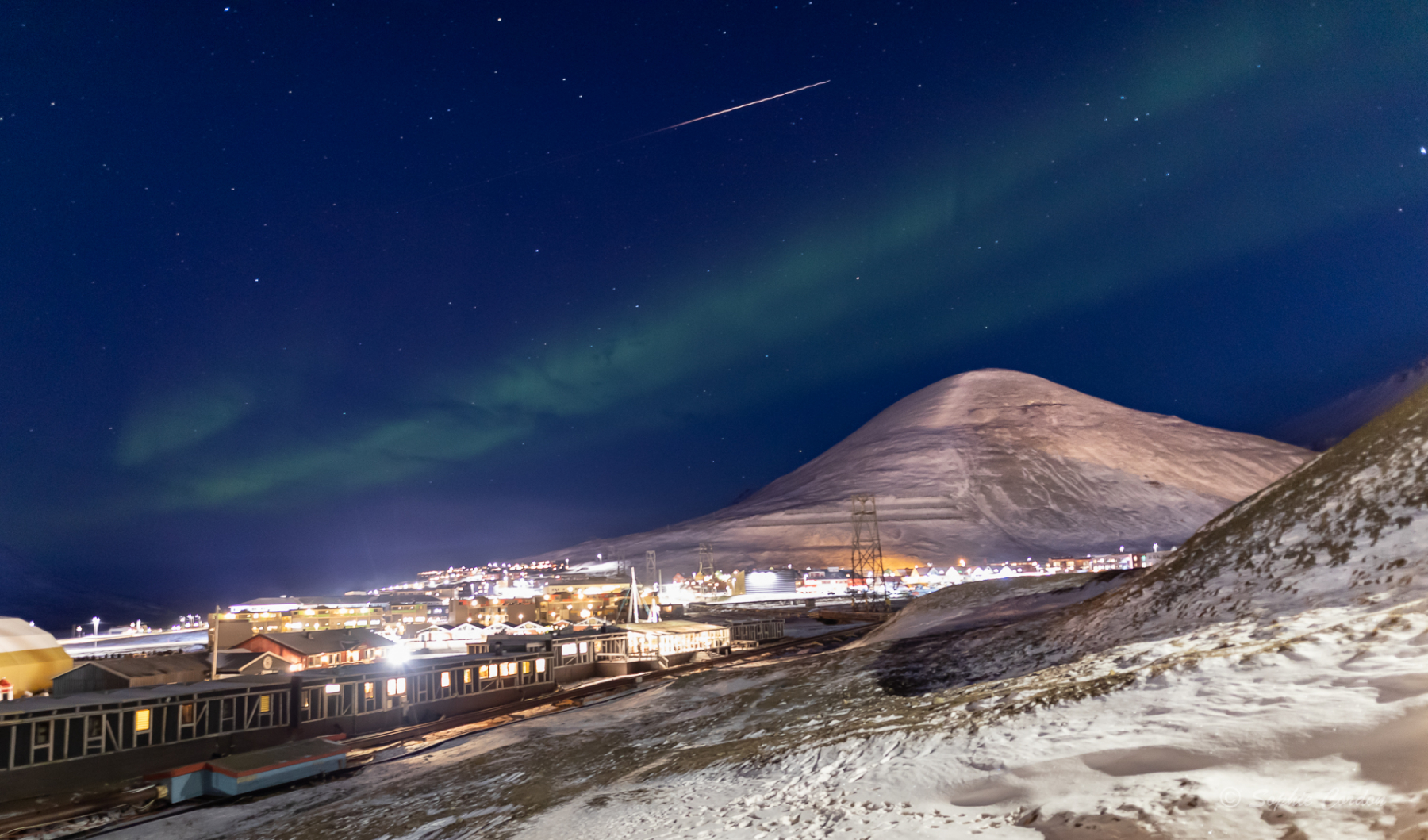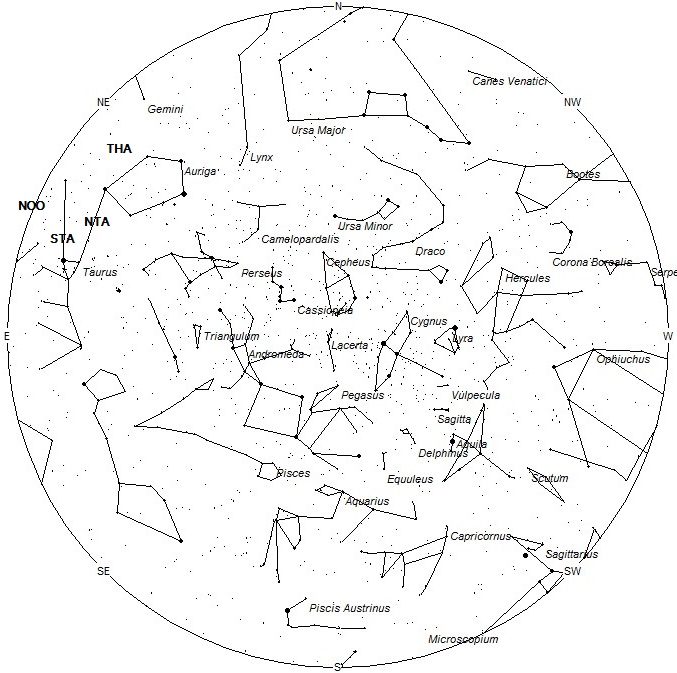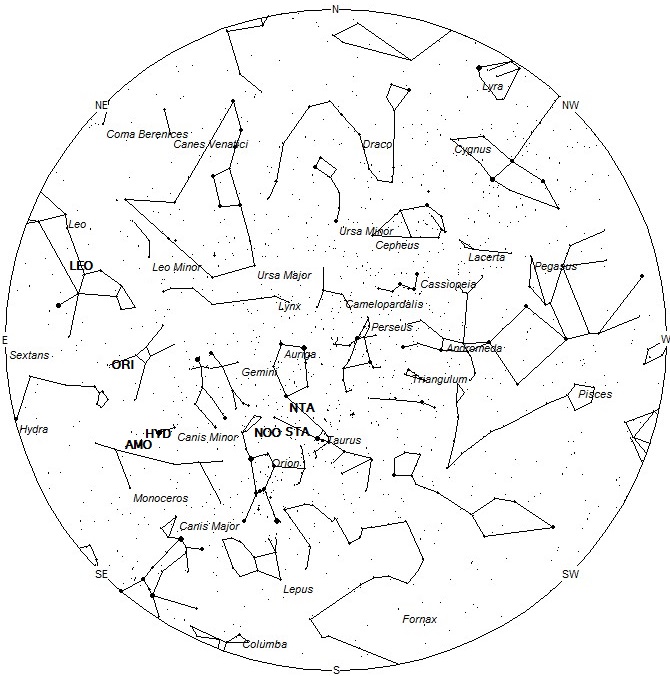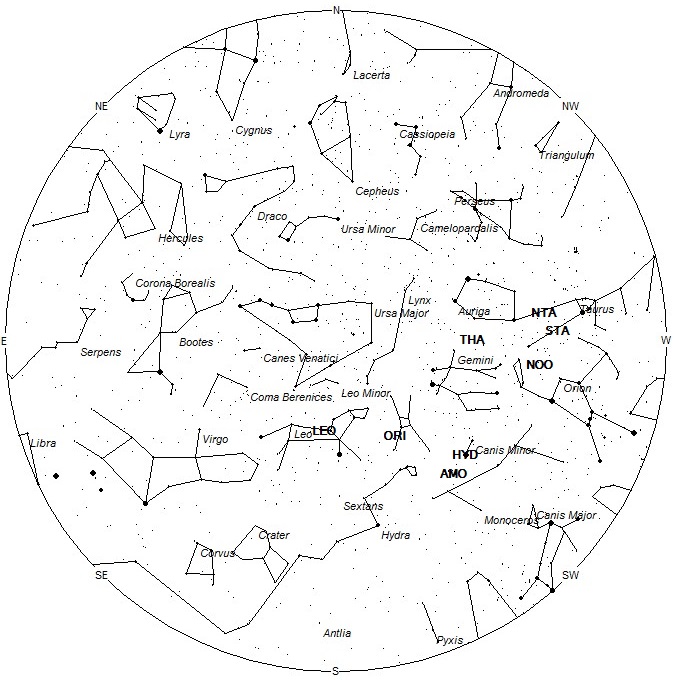
During this period the moon reaches its new phase on Wednesday November 27th. At this time the moon will be located near the sun and will be invisible at night. This weekend the waning crescent moon will rise during the morning hours but will not affect meteor observations as long as you keep it out of your field of view. The estimated total hourly meteor rates for evening observers this week is near 3 for those viewing from the southern hemisphere and 4 for those located north of the equator. For morning observers the estimated total hourly rates should be near 11 as seen from tropical southern locations (25S) and 18 as seen from mid-northern latitudes (45N). The actual rates will also depend on factors such as personal light and motion perception, local weather conditions, alertness and experience in watching meteor activity. Note that the hourly rates listed below are estimates as viewed from dark sky sites away from urban light sources. Observers viewing from urban areas will see less activity as only the brightest meteors will be visible from such locations.
The radiant (the area of the sky where meteors appear to shoot from) positions and rates listed below are exact for Saturday night/Sunday morning November 23/24. These positions do not change greatly day to day so the listed coordinates may be used during this entire period. Most star atlases (available at science stores and planetariums) will provide maps with grid lines of the celestial coordinates so that you may find out exactly where these positions are located in the sky. A planisphere or computer planetarium program is also useful in showing the sky at any time of night on any date of the year. Activity from each radiant is best seen when it is positioned highest in the sky, either due north or south along the meridian, depending on your latitude. It must be remembered that meteor activity is rarely seen at the radiant position. Rather they shoot outwards from the radiant so it is best to center your field of view so that the radiant lies at the edge and not the center. Viewing there will allow you to easily trace the path of each meteor back to the radiant (if it is a shower member) or in another direction if it is a sporadic. Meteor activity is not seen from radiants that are located below the horizon. The positions below are listed in a west to east manner in order of right ascension (celestial longitude). The positions listed first are located further west therefore are accessible earlier in the night while those listed further down the list rise later in the night.
These sources of meteoric activity are expected to be active this week.
The Northern Taurids (NTA) are active from a large radiant located at 04:46 (072) +26. This area of the sky is located in northern Taurus, 6 degrees southwest of the 2nd magnitude star known as El Nath (beta Tauri). This position is close to the Southern Taurids so care must be taken in separating these meteors. You should have the two radiants near the center of your field of view to properly differentiate these sources. Current rates should be 1 per hour as seen from mid-northern latitudes and less than 1 per hour as seen from south tropical latitudes (25S). These meteors may be seen all night long but the radiant is best placed near 0200 LST when it lies on the meridian and is located highest in the sky. With an entry velocity of 28 km/sec., the average Northern Taurid meteor would be of slow velocity.
The Southern Taurids (STA) are active from a large radiant centered near 04:54 (074) +20. This position lies in central Taurus, 5 degrees northeast of the bright orange star known as Aldebaran (alpha Tauri). These meteors may be seen all night long but the radiant is best placed near 0200 LST when it lies on the meridian and is located highest in the sky. Hourly rates at this time should be less than 1 no matter your location. With an entry velocity of 27 km/sec., the average Southern Taurid meteor would be of slow velocity.
The November Orionids (NOO) are active from a radiant located at 05:44 (086) +16. This area of the sky lies in extreme eastern Taurus, 5 degrees south of the 3rd magnitude star known as Tianguan (zeta Tauri). This radiant is best placed in the sky near 0300 LST, when it lies highest above the horizon. This stream is active from November 7 through December 17, with maximum activity occurring on November 29. Rates should be near 2 per hour as seen from the northern hemisphere and 1 as seen from south of the equator. With an entry velocity of 43 km/sec., most activity from this radiant would be of medium speed.
The November theta Aurigids (THA) were discovered by Dr. Peter Brown using the Canadian Meteor Orbit Radar. This stream is active from November 17 through December 1, with maximum activity occurring on November 26. The radiant currently lies at 06:13 (093) +35, which places it in central Auriga, 3 degrees southeast of the 3rd magnitude star known as Mahasim (theta Aurigae A). This area of the sky is best placed in the sky near 0200 LST, when it lies highest above the horizon in a dark sky. Rates should be less than 1 per hour no matter your location. With an entry velocity of 33 km/sec., most activity from this radiant would be of medium-slow velocity. These meteors are expected to be faint and may be difficult to observe unless viewing conditions are near optimum.
The first of the sigma Hydrids (HYD) should appear this week from a radiant located at 07:37 (114) +05. This area of the sky is located in Canis Minor, near the spot occupied by the brilliant zero magnitude star known as Procyon (alpha Canis Minoris). Since the maximum is not until December 6, rates are expected to be less than 1 per hour no matter your location. These meteors are best seen near 0300 LST, when it lies highest above the horizon in a dark sky. With an entry velocity of 61 km/sec., the average sigma Hydrid meteor would be of swift velocity
The alpha Monocerotids (AMO) are a shower of variable strength capable of outbursts, but usually very quiet. Activity may be seen for a week centered on November 22, but activity is usually limited to November 21-23. Maximum activity this year is expected near 04:50 UT on November 22, when an outburst from this source is possible. Maximum rates are unknown but during the last outburst in 1995, ZHR’s reached 400 for a short time. The radiant lies at 07:47 (117) +01. This area of the sky lies in southeastern Canis Minor, 4 degrees southeast of the brilliant zero magnitude star known as Procyon (alpha Canis Minoris). This radiant is best placed in the sky near 0400 LST, when it lies highest above the horizon in a dark sky. With an entry velocity of 63 km/sec., most activity from this radiant would be of swift velocity.
The last of the Orionids (ORI) are expected this week from a radiant located at 08:40 (130) +14, which places it in central Cancer, 3 degree south of the 4th magnitude star known as Asellus Australis (delta Cancri Aa). Rates should be less than 1 per hour no matter your location. With an entry velocity of 67 km/sec., most activity from this radiant would be of swift speed.
The Leonids (LEO) are still active from a radiant located at 10:43 (161) +19. This position lies 3 degrees east of the 2nd magnitude double star known as Algieba (gamma Leonis). The Leonid radiant is best placed during the last hour before morning twilight when the radiant lies highest in a dark sky. Current rates are expected to be near 3 per hour as seen from the northern hemisphere and 2 per hour as seen from south of the equator. With an entry velocity of 70 km/sec., most activity from this radiant would be of swift speed with numerous persistent trains on the brighter meteors.
As seen from the mid-northern hemisphere (45N) one would expect to see approximately 12 sporadic meteors per hour during the last hour before dawn as seen from rural observing sites. Evening rates would be near 3 per hour. As seen from the tropical southern latitudes (25S), morning rates would be near 8 per hour as seen from rural observing sites and 2 per hour during the evening hours. Locations between these two extremes would see activity between the listed figures.
The list below offers the information from above in tabular form. Rates and positions are exact for Saturday night/Sunday morning except where noted in the shower descriptions.
| SHOWER | DATE OF MAXIMUM ACTIVITY | CELESTIAL POSITION | ENTRY VELOCITY | CULMINATION | HOURLY RATE | CLASS |
| RA (RA in Deg.) DEC | Km/Sec | Local Standard Time | North-South | |||
| Northern Taurids (NTA) | Nov 03 | 04:46 (072) +26 | 28 | 00:00 | 1 – <1 | II |
| Southern Taurids (STA) | Oct 29 | 04:54 (074) +20 | 27 | 00:00 | <1 – <1 | II |
| November Orionids (NOO) | Nov 29 | 05:44 (086) +16 | 43 | 01:00 | 2 – 1 | II |
| November theta Aurigids (THA) | Nov 26 | 06:13 (093) +35 | 33 | 01:00 | <1 – <1 | IV |
| sigma Hydrids (HYD) | Dec 06 | 07:37 (114) +05 | 61 | 03:00 | <1 – <1 | II |
| alpha Monocerotids (AMO) | Nov 22 | 07:55 (119) +01 | 63 | 03:00 | <1 – <1 | III |
| Orionids (ORI) | Oct 22 | 08:40 (130) +14 | 67 | 04:00 | <1 – <1 | I |
| Leonids (LEO) | Nov 18 | 10:43 (161) +19 | 70 | 06:00 | 3 – 2 | I |







 You saw something bright and fast? Like a huge shooting star? Report it: it may be a fireball.
You saw something bright and fast? Like a huge shooting star? Report it: it may be a fireball.  You counted meteors last night? Share your results with us!
You counted meteors last night? Share your results with us!  You took a photo of a meteor or fireball? You have a screenshot of your cam? Share it with us!
You took a photo of a meteor or fireball? You have a screenshot of your cam? Share it with us!  You caught a meteor or fireball on video? Share your video with us!
You caught a meteor or fireball on video? Share your video with us!
2 comments
I live in Wisconsin Rapids, WI. The meteor I saw on Saturday, November 23rd around 5:30 p.m. looked like a bright, white light with a flaming orange tail with sparks coming from it.
This morning approx 6.30 saw what looked like around 20 shooting stars all travelling at a steady speed a similar distance apart and they did not disappear the way shooting stars do, they just carried on their path. At first I thought it might be an aeroplane (but it wasn’t flashing) but there were far too many and they were too high up. I’m in the east Midlands in the UK. Any ideas what this was ? Thanks.